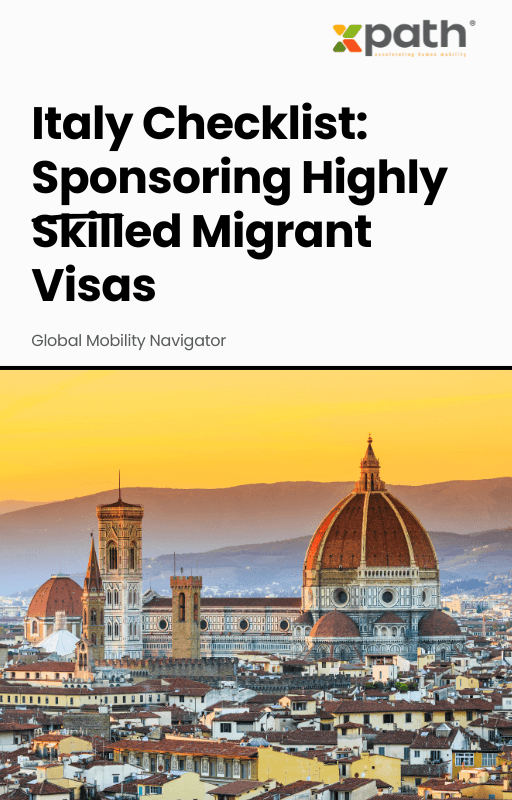Italy Checklist: Sponsoring Highly Skilled Migrant Visas
Grab a copy of a guide to international employee relocation
View E-bookRelocating non-EU employees to Italy under the ICT Permit demands meticulous coordination between HR teams, immigration consultants, employees, and Italian authorities. This guide outlines the step-by-step process—from application to permit collection—to help HR professionals, global mobility managers, and relocation providers streamline operations and ensure compliance.
The ICT Permit (Permesso di Soggiorno per Trasferimento Intra-Societario) is a work authorization governed by Italian Immigration Law (Articles 27-quinquies and 27-sexies) and EU Directive 2014/66/EU. It enables non-EU employees of multinational companies to be temporarily seconded to an Italian branch, subsidiary, or headquarters for managerial, specialized, or training roles. Unlike standard work permits subject to annual Decreto Flussi quotas, the ICT Permit is extra-quota, making it a faster, more flexible option for skilled professionals.
To qualify, employees must meet the following:
🔸Non-EU national employed by a company outside the EU.
🔸At least 12 months of employment within the last 48 months with the same employer or its subsidiaries.
🔸Managers: Senior personnel with decision-making authority.
🔸Specialists: Employees with advanced technical expertise.
🔸Trainees: Degree holders undergoing professional development (max. 1-year permit).
The Italian entity must belong to the same corporate group as the foreign employer.
🔸Up to 3 years for managers/specialists; 1 year for trainees.
🔸Extensions up to 5 years under the National Intra-Company Work Permit.
HR Tip: Verify employment history and role alignment with Ministero dell’Interno requirements early.
The process involves six key stages:
| Step | Details |
|---|---|
| 1. ICT Application | Submit via the local Immigration Office (Sportello Unico per l’Immigrazione). Requires corporate documents, employment contracts, and assignment details. |
| 2. Nulla Osta Approval | Issued within 2–3 months. Confirms no impediment to work. |
| 3. Consular Visa | Employee applies for a Type D Visa at their local Italian consulate (15–30 days processing). |
| 4. Entry & Permit Application | Employee enters Italy and applies for a Permesso di Soggiorno within 8 days. |
| 5. Biometrics & Permit Collection | Attend appointments at the Questura (60 days post-biometrics). |
| 6. 2025 Confirmation Requirement | Employers must confirm continued interest in the permit within 7 days of approval notification via the Visa Information System. |
Key Change for 2025: Missing the 7-day confirmation window results in permit revocation.
🔸Proof of corporate relationship (e.g., Chamber of Commerce registration).
🔸Assignment letter detailing role, salary, and duration.
🔸Contratto di Soggiorno (accommodation and repatriation coverage).
🔸Valid passport, Nulla Osta copy, health insurance, and proof of accommodation.
🔸Completed Kit Giallo forms, fiscal code (Codice Fiscale), and health insurance.
HR Tip: Translate and apostille documents early to avoid delays.
🔸Salary Requirements: Align with Italian standards (e.g., €40,000–€80,000 for specialists/managers).
🔸Social Security: Register employees with INPS and pay contributions.
🔸Tax Compliance: Obtain a Codice Fiscale for tax filings.
Timeline: 3–6 months total (Nulla Osta: 2–3 months; visa: 15–30 days; residence permit: 45–60 days).
Costs:
🔸Visa fee: €100–€116.
🔸Residence permit: €100–€160.
🔸Ancillary costs (translations, legal fees): €500–€1,500.
🔸No Quota Limits: Bypass Decreto Flussi restrictions.
🔸EU Mobility: Transfer employees from other EU member states seamlessly.
🔸Flexibility: Covers managers, specialists, and trainees.
Navigating Italy’s ICT Permit process in 2025 requires proactive planning, adherence to eligibility criteria, and awareness of new compliance rules like the 7-day confirmation mandate. Leverage official resources like the Ministero dell’Interno and partner with experts like xpath.global for complex cases. By preparing documents early and monitoring deadlines, HR teams can ensure smooth, compliant relocations for their global workforce.
For further guidance, consult the Portale Immigrazione or the Italian Ministry of Foreign Affairs.
Ready to transform your mobility program? Explore xpath.global’s solutions.

Italy Checklist: Sponsoring Highly Skilled Migrant Visas
Grab a copy of a guide to international employee relocation
View E-book